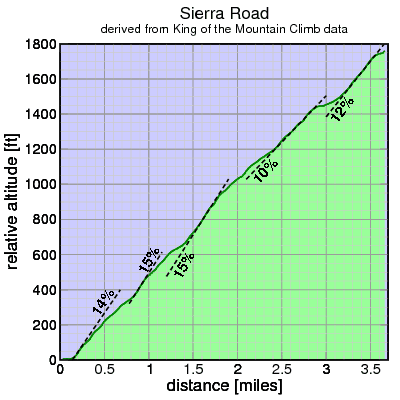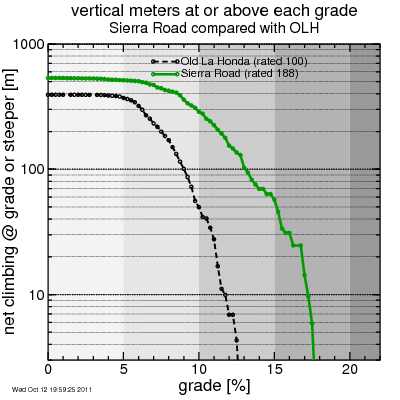Tour of California stage 4: Sierra Road
Tomorrow is only the third summit finish in the history of the Tour of California, the first two being the San Francisco prologue from 2006-2007 which finished on the top of Nob Hill. Tomorrow's climb is a bit tougher...

2007 Low-Key Hillclimbs
I first encountered Sierra Road in Grant Peterson's fantastic Roads to Ride South, a book of route profiles of Bay area climbs from the 1990-era. It became for me an obvious candidate for the Low-Key Hillclimb series which Kevin Winterfield and I organized for the first time in 1995. And the series will revisit it this year, in week 2.
My next encounter was when I did the Devil Mountain Double in 2000. That was quite a different experience, as it came after having already climbed Mount Diablo, Morgan Territory Road, Patterson Pass, Mines Road, and San Antonio Valley Road. Post-bonk, with tired, legs, it was an exercise in survival. But I did, and finished the 200 miles, albeit after dark.
The Tour of California had the brilliance to include the relatively obscure road in its schedule every year the stage race has been held. Initially, when the race was held in February, the Tour would climb Sierra then descent Felter Empire Road to Calaveras Road and then race down flat, suburben streets into downtown San Jose. This finish made it very challenging for riders to use the hill to gain time.
The last two years, Sierra Road has been early in the stage, coming just a few miles after riders had started in San Jose. This reduced the menacing climb to a promenade, a springboard for a suicide break with little hope of surviving the subsequent miles.
This year, finally, Sierra Road is taking the place it deserves, as a summit finish. Here's the official stage page. And while a lot of attention has been placed on the penultimate stage in the race, I feel the results on Sierra Road will have the greatest influence on the final top ten in GC.
Here's a profile of the climb:

It starts out rudely, a well-paved suburban road rising suddenly. This section maybe looks even worse than it is, because after only 30 meters or so of vertical the grade starts to relent from the initial 14%. In fact, one is tempted to think the opening grade was merely an anomaly, and from here it's going to setting into something on the sustainable side of 10%.
But no luck. After clearing suburbia, the grade kicks up again: first for another 100 vertical feet at 15%, then a but of relief, but then a leg-cracking 250 vertical feet again at 15%. If there's an attack on the climb as opposed to a battle of attrition, it will probably come here.
At the end of this section, 1000 feet have been gained in total, and with the exception of a few brief indulgences, the steepest stuff is done. Yet with tired legs there's still 250 feet averaging 10%, then 220 feet averaging around 12%. Finally, the gradual "sprint" to the finish.
Epic.
Here's a breakdown of the total climbing at each grade or higher, comparing Sierra Road to what I consider the canonical climb, Old La Honda Road... this one is in meters (apoligies for the inconsistency):

The total climb is around 520 meters (grade 0 or higher). But 300 meters of those 520 are at or in excess of 10%, with 35 meters at or above 15%. There's climbs around here which dig deeper into that > 15% territory, but that time in the 10% - 15% range takes its toll.
Of course tomorrow the leaders will blow up this thing, making the grades look tame. But the presence of steep grades early on will break the drafting tether and allow splits to form, with the grade the rest of the way steep enough that cooperation among chasers will never be enough to overcome weakness in climbing. It will be a very exciting finish.

2007 Low-Key Hillclimbs
I first encountered Sierra Road in Grant Peterson's fantastic Roads to Ride South, a book of route profiles of Bay area climbs from the 1990-era. It became for me an obvious candidate for the Low-Key Hillclimb series which Kevin Winterfield and I organized for the first time in 1995. And the series will revisit it this year, in week 2.
My next encounter was when I did the Devil Mountain Double in 2000. That was quite a different experience, as it came after having already climbed Mount Diablo, Morgan Territory Road, Patterson Pass, Mines Road, and San Antonio Valley Road. Post-bonk, with tired, legs, it was an exercise in survival. But I did, and finished the 200 miles, albeit after dark.
The Tour of California had the brilliance to include the relatively obscure road in its schedule every year the stage race has been held. Initially, when the race was held in February, the Tour would climb Sierra then descent Felter Empire Road to Calaveras Road and then race down flat, suburben streets into downtown San Jose. This finish made it very challenging for riders to use the hill to gain time.
The last two years, Sierra Road has been early in the stage, coming just a few miles after riders had started in San Jose. This reduced the menacing climb to a promenade, a springboard for a suicide break with little hope of surviving the subsequent miles.
This year, finally, Sierra Road is taking the place it deserves, as a summit finish. Here's the official stage page. And while a lot of attention has been placed on the penultimate stage in the race, I feel the results on Sierra Road will have the greatest influence on the final top ten in GC.
Here's a profile of the climb:

It starts out rudely, a well-paved suburban road rising suddenly. This section maybe looks even worse than it is, because after only 30 meters or so of vertical the grade starts to relent from the initial 14%. In fact, one is tempted to think the opening grade was merely an anomaly, and from here it's going to setting into something on the sustainable side of 10%.
But no luck. After clearing suburbia, the grade kicks up again: first for another 100 vertical feet at 15%, then a but of relief, but then a leg-cracking 250 vertical feet again at 15%. If there's an attack on the climb as opposed to a battle of attrition, it will probably come here.
At the end of this section, 1000 feet have been gained in total, and with the exception of a few brief indulgences, the steepest stuff is done. Yet with tired legs there's still 250 feet averaging 10%, then 220 feet averaging around 12%. Finally, the gradual "sprint" to the finish.
Epic.
Here's a breakdown of the total climbing at each grade or higher, comparing Sierra Road to what I consider the canonical climb, Old La Honda Road... this one is in meters (apoligies for the inconsistency):

The total climb is around 520 meters (grade 0 or higher). But 300 meters of those 520 are at or in excess of 10%, with 35 meters at or above 15%. There's climbs around here which dig deeper into that > 15% territory, but that time in the 10% - 15% range takes its toll.
Of course tomorrow the leaders will blow up this thing, making the grades look tame. But the presence of steep grades early on will break the drafting tether and allow splits to form, with the grade the rest of the way steep enough that cooperation among chasers will never be enough to overcome weakness in climbing. It will be a very exciting finish.

Comments
Horner's SRM data are here:
http://www.cascadegranfondo.com/blog/toc-stage-4-%E2%80%93-first-summit-finish-history-tour-cali
This seems to show his time at around 18:54 (I used g3data), although the data aren't good enough resolution to differentiate from 18:32, I suspect.
16:45 would correspond to a VAM of 1910. That's not a Chris Horner type number. So I think his actual time was similar to what I estimated here -- mid-18.